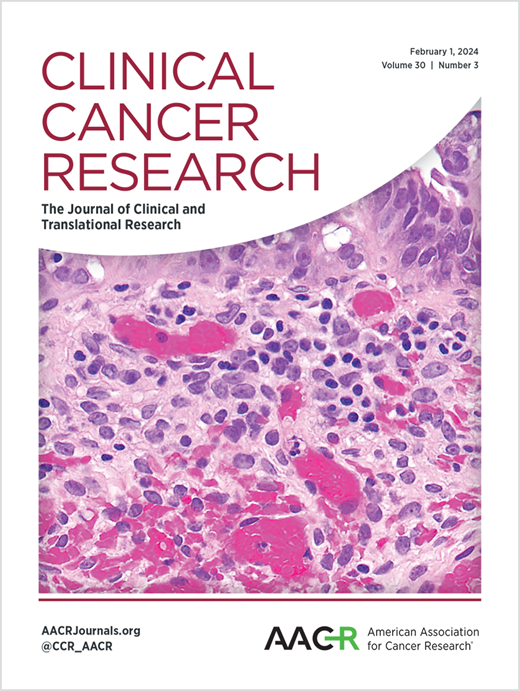Nivolumab和Relatlimab用于治疗不可切除或转移性错配修复熟练的结直肠癌患者
IF 10
1区 医学
Q1 ONCOLOGY
引用次数: 0
摘要
目的:联合抑制淋巴细胞活化基因3 (LAG-3)和程序性细胞死亡蛋白1 (PD-1)可改善黑色素瘤患者的预后。结直肠癌(CRC)中LAG-3表达升高与生存率降低相关。在错配修复精通(pMMR) CRC肿瘤微环境(TME)中,较高的粘蛋白和PD-L1表达与LAG-3升高有关,并与PD-1阻断后延长的无进展生存期有关。这导致了一种假设,即LAG-3/PD-1抑制会改善pMMR CRC亚群的临床结果。患者和方法:NCT03642067是一项2期研究,评估了联合relatlimumab (lag3抑制剂)和nivolumab (PD-1抑制剂)治疗先前治疗过的转移性pMMR CRC患者。患者被纳入三个队列中的一个,A:粘蛋白/PD-L1高,B:粘蛋白/PD-L1低,或C:粘蛋白/PD-L1未选择。每个队列的主要终点是总有效率。结果:我们入组了59例可评估患者;最佳治疗反应为部分缓解:3,病情稳定:6,病情进展:50。应答率在队列之间没有显著差异。亚组分析显示,5例仅肺转移的患者中有2例有部分缓解。肝和肺转移的比较发现,肺病变中基线树突状细胞密度较高。Nivolumab/ relatlimumab导致肿瘤内细胞毒性T细胞增加。较低的基线肿瘤内Tregs和ADAM10+癌细胞与临床反应相关。结论:该研究没有达到三个治疗队列中的任何一个的主要终点,但确实提供了nivolumab/ relatlimumab联合治疗CRC TME的关键见解,并确定了可能从该联合治疗中获得更大益处的亚组。本文章由计算机程序翻译,如有差异,请以英文原文为准。
Nivolumab and Relatlimab for the treatment of patients with unresectable or metastatic mismatch repair proficient colorectal cancer
Purpose: Combined inhibition of lymphocyte-activation gene 3 (LAG-3) and programmed cell death protein 1 (PD-1) improves outcomes in patients with melanoma. Increased LAG-3 expression in colorectal cancer (CRC) correlates with reduced survival. Higher mucin and PD-L1 expression in the mismatch repair proficient (pMMR) CRC tumor microenvironment (TME) was associated with increased LAG-3 and retrospectively with prolonged progression-free survival upon PD-1 blockade. This led to the hypothesis that LAG-3/PD-1 inhibition would improve clinical outcomes in this pMMR CRC subset. Patients and Methods: NCT03642067 was a phase 2 study evaluating combining relatlimab (LAG-3 inhibitor) and nivolumab (PD-1 inhibitor) in patients with previously treated metastatic pMMR CRC. Patients were enrolled onto one of three cohorts, A: mucin/PD-L1 high, B: mucin/PD-L1 low, or C: mucin/PD-L1 unselected. The primary endpoint for each cohort was overall response rate. Results: We enrolled 59 evaluable patients; best treatment responses were partial response: 3, stable disease: 6, progressive disease: 50. Response rates did not differ significantly between cohorts. Subgroup analyses demonstrated 2 of 5 patients with lung-only metastases had a partial response. Comparison of liver and lung metastases identified higher baseline dendritic cell densities in lung lesions. Nivolumab/relatlimab resulted in increased intratumoral cytotoxic T cells. Lower baseline intratumoral Tregs and ADAM10+ cancer cells correlated with clinical response. Conclusions: This investigation did not reach its primary endpoint for any of the three treatment cohorts, but does provide critical insight into the effects of combining nivolumab/relatlimab on the CRC TME and identifies subgroups that may derive greater benefit from this combination.
求助全文
通过发布文献求助,成功后即可免费获取论文全文。
去求助
来源期刊

Clinical Cancer Research
医学-肿瘤学
CiteScore
20.10
自引率
1.70%
发文量
1207
审稿时长
2.1 months
期刊介绍:
Clinical Cancer Research is a journal focusing on groundbreaking research in cancer, specifically in the areas where the laboratory and the clinic intersect. Our primary interest lies in clinical trials that investigate novel treatments, accompanied by research on pharmacology, molecular alterations, and biomarkers that can predict response or resistance to these treatments. Furthermore, we prioritize laboratory and animal studies that explore new drugs and targeted agents with the potential to advance to clinical trials. We also encourage research on targetable mechanisms of cancer development, progression, and metastasis.
 求助内容:
求助内容: 应助结果提醒方式:
应助结果提醒方式:


